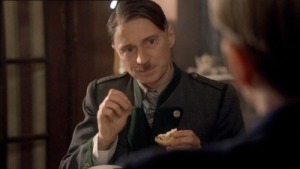 |
| One does not simply do good visual narration in TV films... |
It has been
quite a time since my last blogpost here. Time to step in again with an
interesting topic: TV films and their struggle in finding a way of adequate use
of their video and audio track. The last time I wrote about this, I
attacked this German TV film for its overuse of the audio track. To specify
this argument, most of the audio track was also used as records of dialogue
which makes things even worse by doing the fault of only following the
characters.
The problem
of the German film from my former post is its ratio of audio-visual narration.
Other great TV formats like Columbo
also used the audio track, and especially dialogue, the dialogue between Lt.
Columbo and the murderer, as the main track for narration. But they also did
use the video track indeed, e.g. for jokes or metonyms of Columbo’s appearances
(like detail shots of his cigar, his car, his raincoat, or even sometimes
invented new ones like his ruff in one of my favorite episodes), or for long
sequences without dialogue, mostly in the first 15-25 minutes when the murder
takes places and sometimes when the murderer again is out for action.
So, I would
state that a matching approximate value of audio to visual storytelling should
be 2:1 for TV films (contrary to 1:2 or even 1:3 for movies). The problem of Das Alter der Erde or other German TV
production is that the ratio there is more like 999:1 and therefore is out of
balance. There is one moment in the film where the visual possibilities are
used for focalization, though this moment is destroyed just afterwards when the
person they were showing a few seconds ago had to say something to be also
found on the audio track.
Is this a
German problem only?
I am not sure, but it is a German problem indeed.
As a
comparison, I will use the British TV film Hitler:
The Rise of Evil to show how other TV films use the visual track
creatively.
Some thoughts
on Hitler at first:
It starts
with a rugged exposition but then becomes interesting as a film about the
Weimar Republic. Robert Carlyle is not an adequate cast as Hitler, and the film’s
insane Hitler in one-dimensional and in the portrayal here quite problematic.
The film is
doing something right with its arrangement of its constellation of figures:
Their side characters and their developments are interesting. Live Schreiber’s
character at first cares about profiting from Hitler’s rise financially and not
his ideology and will always remain distant towards the later Fuehrer despite
his support for him. It is unusual to see Schreiber playing a weak character.
His wife, though, will be brought near the National Socialism by him and will
stay in Germany at the end of the film, when Schreiber’s character leaves.
 |
| Peter O'Toole as Paul von Hindenburg. |
The
reporter Fritz is a strong character though his physical appearance is contrary
to Schreiber’s. His relationship with his wife is authentic. Then, there’s Paul
von Hindenburg in his ridiculously oversized uniform from former days which is
an interesting attempt of characterization, though not really matching with the
historical Hindenburg who also was not the same old man as Peter O’Toole. An
interesting try of the film anyway. And there also is Röhm, the conservative SA
leader, always ready for the use of violence, who later would not keep up with
the times. Which is also interesting, though in some sense not historically accurate,
is how the film tells about the intrigues between the German chancellors and
candidates for the position. Within this constellation, the film gains party a
very high tension through destructive situations: Hitler’s niece will be pushed
towards suicide, the success of the NSDAP, the developments which seem like
they could have been prevented.
And then,
there are always some beautiful shots:
A great
scene is, for instance, Röhm’s death: He will be put in prison with a revolver,
giving him the chance to commit suicide, which he does not. When armed SS men
appear, Röhm rises, doing a Nazi salute and shouting: “Heil Hitler!” The moment
after, he will be executed by machine gun fire with blood spreading everywhere.
Then, there
is the scene when Fritz talks to Hitler. Hitler eats some pastry made by Fritz’
wife, when suddenly due to their conversation he madly starts to rage with
pastry in his mouth which causes crumbs to fly through the whole place.
Another
beautiful shot is a glass shot of Eva Braun mirroring herself in a photo of her
beloved Adolf. This short moment does more than all dialogue of the film show
her desire for this man.
A last nice
shot, or even two of them, are to be mentioned from the film’s ending. Fritz’
wife who would never be actually informed about her husband’s death in a
concentration camp gets a package of Fritz’ slightly bloody glasses. The detail
shot of the glasses is followed by an extreme close-up of her eyes.
Not
to forget about one last amazing shot when the German characters
whoonly speak English sing the German anthem with English accents:
Hitler is also a
film which focuses on narration through dialogue. In some of its interesting
scenes, the film’s audio and video track interact to narrate special motifs. In
other scenes, the film only uses the video track to record small but strong moments
which possibly will not be remembered afterwards but dramatize motifs just at
their moment.
Also, the
music will not be remembered for most of the running time but when it will, it
is catchy:
The end
title of Hitler: The Rise of Evil:
Both Autonomous and reminding of Schindler’s
List at the same time.

Keine Kommentare:
Kommentar veröffentlichen